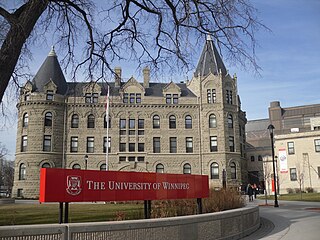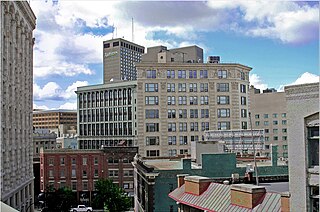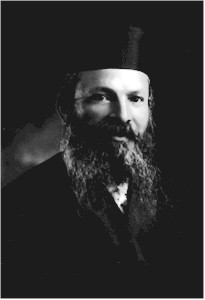
Manitoba is a province of Canada at the longitudinal centre of the country. It is Canada's fifth-most populous province, with a population of 1,278,365 as of 2016. The easternmost of the three prairie provinces, Manitoba covers 649,950 square kilometres (250,900 sq mi) of widely varied landscape, from arctic tundra and the Hudson Bay coastline in the north to dense boreal forest, large freshwater lakes, and prairie grasslands in the central and southern regions.

Winnipeg is the capital and largest city of the province of Manitoba in Canada. It is centred on the confluence of the Red and Assiniboine rivers, near the longitudinal centre of North America.

Canada has a large domestic and foreign tourism industry. The second largest country in the world, Canada's incredible geographical variety is a significant tourist attractor. Much of the country's tourism is centred in the following (busiest) regions: Toronto, Montreal, Vancouver/Whistler, Niagara Falls, Vancouver Island, Calgary/Canadian Rockies, British Columbia's Okanagan Valley, and the national capital region Ottawa. The large cities are known for their culture, diversity, as well as the many national parks and historic sites.

St. Boniface is a city ward of Winnipeg that is the centre of much of the Franco-Manitoban community. It features such landmarks as the St. Boniface Cathedral, Boulevard Provencher, the Provencher Bridge, Esplanade Riel, St. Boniface Hospital, the Université de Saint-Boniface and the Royal Canadian Mint. It covers the southeast part of the city and includes le Vieux Saint-Boniface, Norwood West, Norwood East, Windsor Park, Niakwa Park, Niakwa Place, Southdale, Southland Park, Royalwood, Sage Creek and Island Lakes, plus a large industrial area. The ward is represented by Matt Allard, a member of Winnipeg City Council, and also corresponds to the neighbourhood clusters of St. Boniface East and West. The population was 58,520 according to the Canada 2016 Census.

Ukrainian Canadians are Canadian citizens of Ukrainian descent or Ukrainian-born people who immigrated to Canada. In 2016, there were an estimated 1,359,655 persons of full or partial Ukrainian origin residing in Canada, making them Canada's eleventh largest ethnic group and giving Canada the world's third-largest Ukrainian population behind Ukraine itself and Russia. Self-identified Ukrainians are the plurality in several rural areas of Western Canada. According to the 2011 census, of the 1,251,170 who identified as Ukrainian, only 144,260 could speak the Ukrainian language.

The Manitoba Museum, previously the Manitoba Museum of Man and Nature, is a historical museum in Winnipeg, Manitoba, as well as the province’s largest, not-for-profit centre for heritage and science education.
Sol Kanee, was a Canadian lawyer, former President of Canadian Jewish Congress from 1971 to 1974, former Chairman of the World Jewish Congress Board of Governors, the longest-serving member, for 17 years, of the board of governors of the Bank of Canada, and chairman of the Federal Business Development Bank, 1975–78.
Winnipeg North was a provincial electoral division in Manitoba, Canada. It existed on two separate occasions.
The Manitoba Metis Federation is an Indigenous organization in Manitoba, Canada. Its current president is David Chartrand. MMF is an affiliate of the Métis National Council.
Gail Sheryl Asper, is president and a trustee of The Asper Foundation, the private charitable foundation spearheading the establishment of the $351 million Canadian Museum for Human Rights (CMHR) in Winnipeg. The CMHR is the first national museum established outside of Ottawa, Canada. Its image now adorns Canada's new $10 bill. On August 26, 2008, Asper was appointed to the board of trustees of the Canadian Museum for Human Rights by the Stephen Harper government.

The Exchange District is a National Historic Site of Canada in the downtown area of Winnipeg, Manitoba, Canada. Just one block north of Portage and Main, the Exchange District comprises twenty city blocks and approximately 150 heritage buildings, and it is known for its intact early 20th century collection of warehouses, financial institutions, and early terra cotta clad skyscrapers.

The Costume Museum of Canada is an institution dedicated to the history of fashion and clothing. The collection is located in Winnipeg, Manitoba, Canada. The museum gallery space was closed to the public in 2010 but the Costume Museum of Canada continues to offer programs such as: pop-up exhibits, heritage fashion revues, hat shows and other educational programs. It is also active on social media and operates a website: https://www.costumemuseumcanada.com/

The Living Prairie Museum is a 30-acre (12 ha) tall grass prairie preserve located between Daisy Road and Harcourt Street, east of Ness Ave. in the St. James-Assiniboia suburb in Winnipeg, Manitoba.

Winnipeg is well known across the prairies for its arts and culture.

Manitoban culture is a term that encompasses the artistic elements that are representative of Manitoba. Manitoba's culture has been influenced by both traditional and modern Canadian artistic values, as well as some aspects of the cultures of immigrant populations and its American neighbours. In Manitoba, the Minister of Culture, Heritage, Tourism and Sport is the cabinet minister responsible for promoting and, to some extent, financing Manitoba culture. The Manitoba Arts Council is the agency that has been established to provide the processes for arts funding. The Canadian federal government also plays a role by instituting programs and laws regarding culture nationwide. Most of Manitoba's cultural activities take place in its capital and largest city, Winnipeg.

Riel House is a National Historic Site commemorating the life of the Métis politician and activist Louis Riel, and also the daily life of Métis families in the Red River Settlement. The house is situated in the historic St. Vital parish, Winnipeg in Manitoba Canada. From 1865, the residence belonged to Riel's mother, Julie Riel (Lagimodière), and housed his brothers and their families. Louis Riel lived along with them from his return to Red River in 1868, through the Red River Resistance, until his exile in 1870. It is also where his body lay in state for two days in December 1885 after his sentencing and execution for murder and treason, before being buried in St. Boniface. The house remained within the possession of Riel descendants until 1968, when it was acquired by the Winnipeg Historical Society.

Israel Isaac Kahanovitch was a Polish Canadian Orthodox Jewish rabbi who served as Chief Rabbi of Winnipeg and Western Canada for nearly 40 years. Widely respected for his Talmudic erudition and oratory skills, he strengthened Jewish educational, religious, and social institutions and worked to bridge the divide between religious and secular Jews in Canada. He was a founding member of the Canadian Jewish Congress. In 2010, he was named a Person of National Historic Significance by the Government of Canada.
The Canadian Western Jewish Times, established in 1914, was the first Jewish newspaper published in English in Western Canada and the earliest attempt to produce a Western Canadian regional Jewish newspaper in English. Like many other efforts to publish Jewish newspapers in Canada between 1891 and the first decades of the 20th century, it proved to be ephemeral.

Leah Gazan is a Canadian politician who was elected to represent the riding of Winnipeg Centre in the House of Commons of Canada in the 2019 Canadian federal election.














